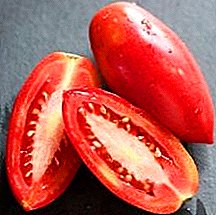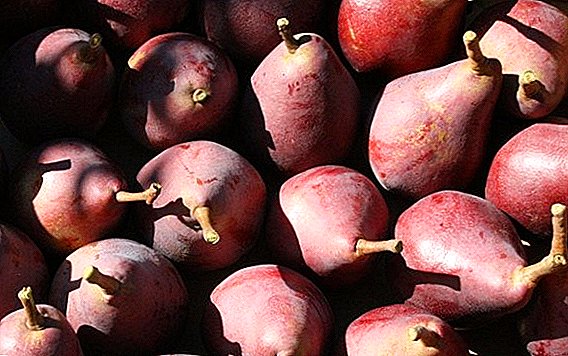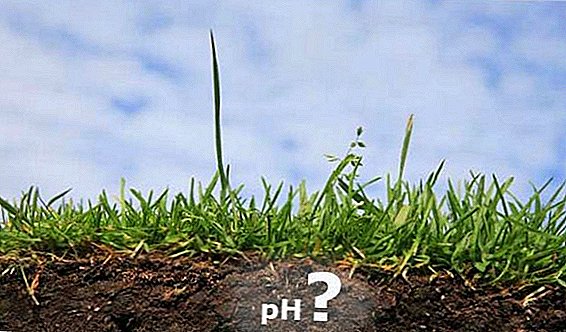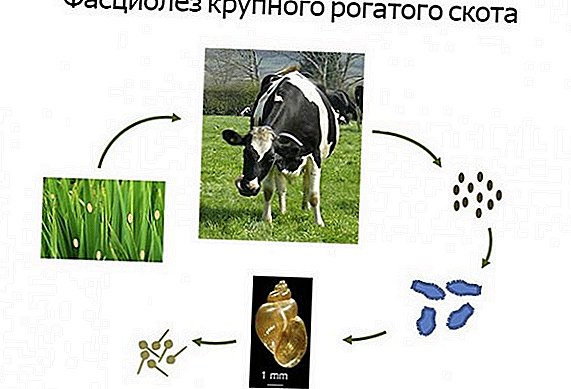 One of the most common diseases in cattle, which has characteristic symptoms and leads to serious consequences, is fascioliasis.
One of the most common diseases in cattle, which has characteristic symptoms and leads to serious consequences, is fascioliasis.
About why it is so dangerous, what symptoms are accompanied, and how a person can help a sick animal, read our material.
What is fascioliasis?
In simple terms, fascioliasis is worms that affect the liver and gall bladder. They cause serious harm to the animal. In advanced cases, their livelihoods can lead to the death of livestock. Thus, the disease leads to serious economic damage to livestock farms. Each cattle infected with fascioliasis loses from 24 to 41 kg of live weight. A cow for a year can not add 223 kg of milk. With timely treatment started, the prognosis of the course of the disease is positive. Full recovery occurs after 30-40 days.  Intermediate hosts fasciola The disease can affect almost all types of farm animals, wild animals, as well as humans. Mature individuals are more likely to get sick, in young chicks, fascioliasis is much less common. Often, cases of infection with this helminth disease are recorded at the end of summer, in winter animals are not infected.
Intermediate hosts fasciola The disease can affect almost all types of farm animals, wild animals, as well as humans. Mature individuals are more likely to get sick, in young chicks, fascioliasis is much less common. Often, cases of infection with this helminth disease are recorded at the end of summer, in winter animals are not infected.
Such infectious diseases of cattle are dangerous for humans: leukemia, brucellosis, rabies, actinomycosis, leptospirosis.
Causative agent and development cycle
Trematodes of the Fasciola family provoke the disease: Fasciola hepatica - hepatic fluke and Fasciola gigantica - giant fluke. The first parasite has a length of 2 to 3 cm, the second - up to 7.5 cm.  Their main hosts are ruminants, while the intermediate hosts are mollusks. Trematodes lay eggs, which together with the feces are in the environment. From eggs goes miracidians. After being released into the water, it settles in the intermediate host, where it develops for about 2.5 months. Then the parasites emerge from the mollusk into the water and move to the grass, where they live until the end of the pasture season.
Their main hosts are ruminants, while the intermediate hosts are mollusks. Trematodes lay eggs, which together with the feces are in the environment. From eggs goes miracidians. After being released into the water, it settles in the intermediate host, where it develops for about 2.5 months. Then the parasites emerge from the mollusk into the water and move to the grass, where they live until the end of the pasture season.
Did you know? If in the dark a cow will look at the lights or a flashlight, her eyes will glow. This is due to the fact that in her organs of vision there is a special pigment that reflects light and enhances its low levels.
Sources and routes of infection
Thus, there may be two sources of infection with fascioli:
- drinking water;
- herb eaten.
 Once in the livestock organism, parasites move along the gastrointestinal tract into the biliary passages of the liver, where they settle for their harmful activity, destroying the cells of internal organs and releasing toxic toxins. There they can be up to 4-5 years.
Once in the livestock organism, parasites move along the gastrointestinal tract into the biliary passages of the liver, where they settle for their harmful activity, destroying the cells of internal organs and releasing toxic toxins. There they can be up to 4-5 years.
Symptoms and course of the disease
Symptoms may vary depending on the form of the disease. They will be different for acute and chronic forms. Also, the signs may differ depending on the type of fasciol that struck the animal, the conditions of detention and feeding, the stability of the immune system. So, if there are a small number of parasites in the body, the livestock has a strong immunity, then the disease may be asymptomatic or with very mild signs that the owner may not even pay attention to.
Acute form
In the acute form, the following symptoms are most often recorded:
- increase in body temperature to 41.5 degrees;
- loss of appetite, refusal to eat;
- vomiting;
- violations of the gastrointestinal tract;
- depressed state;
- enlarged liver;
- tension of the abdominal muscles;
- heart rhythm disorder;
- skin sensitization.
 If acute fascioliasis is not treated in time, then it will become chronic.
If acute fascioliasis is not treated in time, then it will become chronic.
Read more about other diseases of cattle that are caused by parasites: dictyocaulosis, hypodermatosis, teliasiosis.
Chronic
For the chronic course of the disease the following symptoms are characteristic:
- lethargy, drowsiness;
- sudden weight loss;
- fading and hair loss;
- significant reduction in the amount of milk;
- blanching of mucous membranes.

Diagnostics
The diagnosis of "fascioliasis" is made on the basis of examining the animal and identifying its characteristic symptoms, as well as the results of stool tests conducted in the laboratory.
Pathological changes
If the animal has died, then by opening, fasciols are found in its hepatic biliary tracts. In the liver, there are also ruptures of the mucous membrane, small foci of necrosis, cellular infiltration, and destroyed areas. In severe cases, cirrhosis is detected.
Also, the changes will be visible in the organs of the digestive tract. So, hemorrhages are found in the duodenum, the gallbladder is in an expanded state.
Did you know? On the skin that covers the nose of the cow, there is a unique pattern by which the animal can be identified as a person by fingerprints.
How to cure a cow with fascioliasis
If a fascioliasis is detected, the treatment will consist of 3 stages: disinvasion of the premises, which contains livestock, disinfection of manure and the introduction of animal drugs. 
General control measures
Manure is disinfected by the biothermal method in manure depots and on sites that are inaccessible to animals. Clean it with a special inventory, intended only for this purpose, and placed in a pile of no more than 1 cu. As soon as the temperature starts to rise (this happens by itself, without committing additional actions), the manure is tamped down and the new batch is filled. After long storage (about 4-6 months) in manure depots or on sites it is taken out to the field.
After deworming, the feces, the room, the walking place and the equipment are disinfessed for 5-6 days by mechanical cleaning and heat treatment with boiling water or weak disinfecting solutions, which are also used hot.
Drugs
In modern veterinary medicine, fascioliasis is treated with several preparations with different active ingredients:

- "Clozatrem". Available in sterile vials of 100 and 250 ml. The main active ingredient is closantel. It has a wide spectrum of action, fights against various types of parasites that are at different stages of development - from larvae to mature individuals. It is administered once intramuscularly or subcutaneously in a dose of 0.5 ml per 10 kg of mass. The maximum effect is achieved 10-12 hours after the injection. After the introduction of the milk can be consumed after a month, the meat - after 28 days;
- "Retryl". The drug is a broad-spectrum, killing various types of parasites, acting on them at different stages of development. The active ingredients are ricobendazole, triclabendazole. The tool can be used for both treatment and prevention. The drug is administered intramuscularly at a dose of 1.6 ml per 10 kg of animal weight. Meat can be consumed 40 days after the injection of anthelmintic injections;
Important! Fasciolosis requires compulsory treatment. In case of therapy with medications, you should follow the recommendations of the veterinarian and the instructions attached to the drug. It is forbidden to prescribe drugs by yourself or move away from the prescribed dosage. Unauthorized actions can harm the health of the animal, since all drugs have side effects.
- "Hexachloroparaxylene". Available in powder form. Homes in food, grain or feed. It is given once - 0.5 g per 1 kg of weight to 1 animal;
- "Acemidophen". Available in the form of an aqueous suspension. Given at a dosage of 0.15 g per 1 kg of weight. The drug is mixed with feed. For treatment requires a single injection. Milk and meat can be consumed 14 days after the animal consumed the medicine;
- "Sulfen". Dosage - 0.05-0.1 g per 1 kg of weight. Mixed with feed;
- "Disalane". Dosage - 0.01-0.015 g per 1 kg of weight. It is given by the group method, mixed with food;
- "Dertil B" give animals on the basis of the calculation of 0.004-0.006 g / kg or 1 tablet per 100 kg of weight.
Can I drink milk and eat meat from an infected animal
Since people can become infected with fascioliasis, it is impossible to eat meat and milk of an infected animal. They are also forbidden to feed other pets, for example, cats, dogs.  Meat of an infected animal After the therapy is done, meat and milk cannot be eaten for a certain time. The period of prohibition depends on the remedy used for treatment.
Meat of an infected animal After the therapy is done, meat and milk cannot be eaten for a certain time. The period of prohibition depends on the remedy used for treatment.
Prevention
It is quite difficult to avoid fascioliasis. However, the risk of infection can be reduced by adhering to preventive measures:
- de-worming animals twice a year;
- carry out regular cleaning and disinfection of the room where cattle are kept;
- graze cattle on well drained pasture, isolated from irrigated land;
- do not allow animals to drink water in water bodies that have not passed sanitary control;
- make regular changes of grazing places;
- inspect livestock more often for health status;
- fight shellfish;
- contain animals stall-camp way.
 Year-round stall content protects against fascioliasis
Year-round stall content protects against fascioliasisThus, fascioliasis is a serious helminthic disease of cattle, which must be treated. Since it is not always possible to avoid the disease, the owner of cattle must have anthelmintic agents in the arsenal with which it is possible to start treatment in time and avoid sad consequences.
Important! The introduction of prophylactic drugs carried out for 10-15 days before the cattle will be released on pasture. Drugs are administered in the same doses as in the treatment.The risk of infection with fasciolosis can also be reduced by strictly observing the technology of keeping, drinking and feeding cattle.












